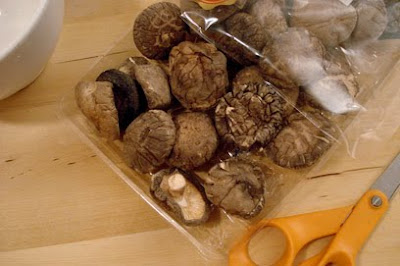Growing up, I ate tons of Korean soups and stews. But it wasn't until I was researching Korean cooking online that I put two and two together to realize that these little anchovies were being used for broth for these soups and stews. The way chicken stock is a staple in Western pantries, this basic fish/seafood broth is a staple in Korean pantries.

I used maangchi's proportions for this particular broth. She uses dried shiitakes also, which I love - the flavor it adds is awesome. (She also uses onion and garlic, but I skipped those.)

In a pot with dried kelp pieces.

Dried anchovy powder that my mom sent to me. This is in lieu of using whole anchovies. Even Koreans, who I'm pretty sure still make kimchi and bury it in their yards, have come up with some shortcuts. (This is a trick my mom learned from my aunt.) The most basic broth can be made with just the anchovies.

I thought it would dissolve in the water but it doesn't. (Now when I make this, I put the anchovy powder into a teabag before putting it in the water. Then I just fish it out of the broth afterward. Get it - fish. Tee hee.)

Boil for ten minutes; simmer for about 20-30.

Strain (reserve the shiitakes for another use), cool and refrigerate, or freeze. I freeze in 1-cup containers, because...

I can heat up one of the containers, with another 1/2 to 1 cup of water, and some seasonings (salt and a little soy sauce - yes salt, even with the soy sauce; the salt brings out the fish/mushroom flavor and the soy sauce is optional but adds a little oomph) to make a really simple broth for a quick noodle soup. I used soba noodles and also sliced up a couple of the shiitakes I had leftover from making this broth.

Perfect meal to go with kaktugi and oi namul!

2 comments:
ingenious, i just use dashida, which does dissolve but cannot possibly taste as good as your stuff. props for working my name into this post.
NL
I've used dashida in the past but found it a little... intense. Food coma anyone? I like this broth [in lieu of dashida - hahaha] because it's a good base for other dishes.
Post a Comment